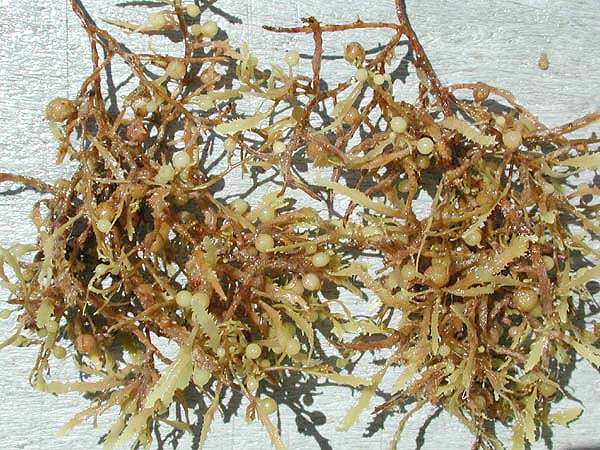- Sargassum
Taxobox
name = "Sargassum"

domain =Eukaryota
regnum =Chromalveolata
phylum =Heterokont ophyta
classis = Phaeophyceae
ordo =Fucales
familia =Sargassaceae
genus = "Sargassum"
subdivision_ranks =Species
subdivision =
*"Sargassum bacciferum ", aka. "Sargassum natans " or "Fucus natans "
*et alSargassum is a genus of generally planktonic (free-floating) macroalgae (
seaweed ) in the orderFucales . It is named for theAtlantic Ocean 'sSargasso Sea , which hosts a large amount of several species of "Sargassum".Description
Species of this genus of
algae may grow to a length of several metres, they are generally brown or dark green in color and consist of aholdfast , a stipe, and afrond .Oogonia andantheridia occur inconceptacles embedded inreceptacles on special branches.Abbott, I.A. and Hollenberg,G.J. 1976. "Marine Algae of California." Stanford University] Some species have berrylike gas-filled bladders which help keep the fronds afloat to promotephotosynthesis . Many have a rough sticky texture, which together with a robust but flexible body, helps it to withstand strong water currents.The thick masses of "Sargassum" provide an environment for a distinctive and specialised group of marine animals and plants, many of which are not found elsewhere.
"Sargassum" is commonly found in the beach drift near "Sargassum" beds where they are also known as Gulfweed, and colloquially as "the weed of deceit", a term also used to include all seaweed species washed up on shore.
"Sargassum" species are found throughout tropical areas of the world and are often the most obvious macrophyte in near-shore areas where "Sargassum" beds often occur near
coral reef s. The plants grow subtidally and attach to coral, rocks or shells in moderately exposed or sheltered rocky or pebble areas. In some cases (e.g. theSargasso Sea ) there are floating populations of "Sargassum"."Sargassum" is sometimes known as "The Weed of Deceit".
"Sargassum muticum" (Yendo) Fensholt
Description
"Sargassum muticum" [http://users.cybercity.dk/~dko10792/poster1.htm] is a large brown seaweed of the Division
Phaeophyta . It grows attached to rocks by a perennialholdfast up to 5 cm in diameter. From this holdfast the main axis grows to a maximum of 5 cm high. The leaf-like laminae and primary lateral branches grow from this stipe. In warm waters it can grow to 12 m long, however in British waters it gives rise to a single main axis with secondary and tertiary branches which are shed annually. Numerous small 2-6 mm stalked air vesicles provide buoyancy. The reproductive receptacles are also stalked and develop in the axils of leafy laminae. It is self fertile.History
The
Florida Keys and its smaller islands are well known for their high levels of "Sargassum" covering their shores. Gulfweed was observed by Columbus. Although it was formerly thought to cover the entirety of theSargasso Sea , making navigation impossible, it has since been found to occur only in drifts."Sargassum muticum" originally from
Japan had by15 March 1995 been found inStrangford Lough ,County Down ,Northern Ireland , this is an extension of the distribution of this invasive species.Herbarium specimens are now stored in theUlster Museum (BEL catalogue numbers: F11241 - F11242; F11182 - F11185). The species was first found in theBritish Isles in theIsle of Wight in 1973. It is thought to have gained worldwide distribution through being transported with Japaneseoyster s. There is much concern about its impact on the coastal environment. It has become a great nuisance forming large detached mats, clogging marinas, recreational areas and other sports facilities. It can foul fishing lines, clog pipes of boats and trap debris.The species is particularly tenacious with fast growth rates, high reproductive rates and an ability to spread vegetatively.
"Sargassum" is also cultivated and cleaned for use as an herbal remedy. Many Chinese herbalists prescribe powdered sargassum in paper packets of 0.5 gm, to be dissolved in warm water and drank as a tea. It is said to remove excess phlegm. When sold in this application it is commonly referred to as Seaweed Sargassum Tea.
"Sargassum" is also cultivated and cleaned for use as an herbal remedy.
Distribution
"Sargassum muticum" has a range stretching from Nanaimo,
British Columbia to Baja inCalifornia .Abbott, I.A. and Hollenberg, G.J. 1976. "Marine Algae of California." Stanford University Press, California, ISBN] InEurope it now extends along the coasts ofGreat Britain ,France ,Scandinavia ,Baltic Sea ,Helgoland ,Netherlands ,Ireland , theIberian Peninsula and into theMediterranean fromItaly and the Adriatic. It is recorded from Japan,China andAlaska .Thomas, D.N. 2002. "Seaweeds." The Natural History Museum, London. ISBN]Life history
Life history. [http://www.mbari.org/staff/conn/botany/browns/jacquie/repro.htm]
Habitat
"Sargassum muticum" grows in from just below low-water mark to a depth of 10 m.
Further reading
* Davison, D.M. 1999. "Sargassum muticum" in Strangford Lough, 1995 - 1998; A review of the introduction and colonisation of Strangford Lough MNR and cSAC by the invasive brown alga "Sargassum muticum". "Environment and Heritage Service Research and Development Series". No.99/27 ISSN 1367 - 1979.
* Critchley, A.T., Farnham, W.F. and Morrell, S.L. 1983. A chronology of new European sites of attachment for the invasive brown alga, "Sargassum muticum", 1973 - 1981. "Journal of the Marine Biological Association of the United Kingdom", 63: 799 - 811.
* Boaden, P.J.S. 1995. The adventive seaweed "Sargassum muticum" (Yendo) Fensholt in Strangford Lough, Northern Ireland. "Ir. Nat. J." 25 111 - 113.
* Davison, D.M. 1999. Sargassum muticum inStrangford Lough , 1995 - 1998; a review of the introduction and colonisation of Strangford Lough MNR and cSAC by the invasivebrown algae "Sargassum muticum".Environmental and Heritage Service Research and Development Series . No. 99/27.References
External links
*http://www.algaebase.org/search/species/detail/?species_id=90&-session=abv4:521DF403192c331D71WPM2E65321
* http://www.marlin.ac.uk/species/Sargassummuticum.htm
* http://www.icais.org/pdf/20Monday/pm/Jamie_Dick.pdf Sargassum in Northern Ireland.
* [http://www.surialink.com/HANDBOOK/Genera/browns/Sargassum/Sargassum.htm The SuriaLink Seaplants Handbook - Sargassum]
* http://www.irishseaweed.com/startpage.htm
* http://www.habitas.org.uk/invasive/
* http://www.seaweed.ie/sargassum/
* http://www.irishseaweed.com/PDF/smutposter.pdf
* http://www.mbari.org/staff/conn/botany/browns/jacquie/repro.htm "Sargassum" - reproduction.
Wikimedia Foundation. 2010.
